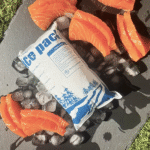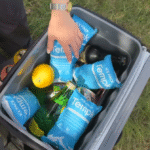Blocos de gelo seco descartáveis para envio: Melhores práticas e tendências em 2025
Introdução:
Envio de produtos sensíveis à temperatura, bens especialmente perecíveis, requer um planejamento cuidadoso para manter as condições certas. Blocos de gelo seco descartáveis são uma solução confiável e eficiente para isso. Neste artigo, exploraremos como funcionam os blocos de gelo seco descartáveis, as melhores práticas para usá-los, e quais tendências estão moldando o futuro do gelo seco em 2025.

Why Should You Choose Blocos de gelo seco descartáveis para envio?
-
Resfriamento eficaz e duradouro: Blocos de gelo seco podem manter temperaturas tão baixas quanto -78,5°C (−109,3 ° F.), ideal para produtos sensíveis como produtos farmacêuticos, comida, e amostras biológicas.
-
Solução econômica: Blocos de gelo seco descartáveis são uma alternativa acessível aos refrigeradores e pacotes de gel reutilizáveis, especialmente para remessas de curto prazo.
-
Simplicidade e Conveniência: Sem necessidade de logística de devolução, esses blocos fornecem uma solução descomplicada para remessas únicas.
Key Benefits of Disposable Dry Ice Blocks
-
Maintains Extremely Low Temperatures: Dry ice blocks keep goods frozen for 24 para 72 horas, ensuring perishable items stay safe.
-
Sem derretimento da água: Ao contrário dos pacotes de gel, which can cause moisture-related damage, gelo seco sublima diretamente em gás CO₂, não deixando nenhum resíduo de água.
-
Versatilidade: Available in blocks, Pellets, and scored sheets, they can be selected based on shipment size and duration.
Exemplo do mundo real: A pharmaceutical company shipping vaccines reduced spoilage by 15% using disposable dry ice blocks, demonstrating their effectiveness in temperature-sensitive logistics.
Best Practices for Using Disposable Dry Ice Blocks
Proper handling and packaging are essential for optimizing the performance of disposable dry ice blocks. Below are the steps to follow:
1. Sizing Your Dry Ice Block
To ensure your shipment remains at the right temperature, it is crucial to calculate the amount of dry ice required:
-
Regra geral: Para um período de envio de 24 horas, use 5–10 lbs of dry ice per box. Adjust based on insulation quality and ambient temperature.
-
Considerações: Longer shipments or hotter climates may require more dry ice to maintain optimal conditions.
Sizing Example
For a shipment of 10 kg of frozen seafood in a 15L insulated box, a 48-hour journey through moderate temperatures would require approximately 1.8 kg de gelo seco.
| Tipo de remessa | Tempo de envio | Requisito de gelo seco | Benefícios |
|---|---|---|---|
| Frutos do mar congelados | 48 horas | 1.8 kg | Ensures frozen goods arrive intact |
| Produtos farmacêuticos | 72 horas | 7.5 kg | Maintains ultracold temperatures and prevents spoilage |
2. Escolha a embalagem certa
Ensure that your shipment is well insulated. Use insulated containers that can withstand the cold temperatures of dry ice and prevent rapid sublimation. Consider using vacuum-insulated panels (VIP) ou poliestireno expandido (EPS) for better performance.
3. Safety and Disposal Considerations
Handling dry ice requires safety precautions:
-
Use luvas isoladas: To avoid frostbite.
-
Garanta ventilação adequada: Gelo seco sublima em gás co₂, which can accumulate in sealed containers and cause pressure build-up.
-
Disposição: Uma vez que o gelo seco sublimado, dispose of it in a well-ventilated area to avoid CO₂ buildup. Never dispose of dry ice in enclosed spaces or down drains.
Tendências no transporte de gelo seco para 2025
The cold chain logistics industry is evolving with new technologies and innovations in packaging materials. Here’s what’s driving the future of disposable dry ice blocks:
1. Smart Packaging and IoT Monitoring
Smart packaging solutions with IoT sensors are becoming increasingly popular, allowing real-time temperature tracking during transit. These systems help companies monitor and adjust shipments, reducing spoilage and improving reliability.
2. Práticas sustentáveis
As demand for eco-friendly solutions grows, companies are turning to hybrid systems that combine dry ice with phase-change materials (PCMs) to reduce CO₂ emissions and improve cost-effectiveness.
3. Advances in Insulation Materials
New insulation technologies, como painéis isolados a vácuo (VIP), are expected to reduce the need for large amounts of dry ice, improving the cost-efficiency of shipments and reducing environmental impact.
Regulamentos de segurança e conformidade
Shipping dry ice requires compliance with regulatory standards. As principais diretrizes incluem:
-
Diretrizes IATA: Packages containing dry ice must be labeled as “Dióxido de carbono, Sólido (Gelo Seco), UN1845” and meet IATA Packing Instruction 954.
-
Regulamentos DOT: Dry ice must be packed in vented containers, and weight limits must be adhered to, typically no more than 5.5 libras (2.5 kg) per package for air shipments.
Failure to comply with these regulations can result in delays and fines.
4. Cost and Sustainability of Disposable Dry Ice Blocks
Dry ice is often a more cost-effective solution compared to reusable coolers or gel packs for short-term shipments. No entanto, several factors can influence cost:
-
Compra em massa: Buying dry ice in bulk can reduce unit costs.
-
Qualidade de isolamento: Upgrading insulation reduces dry ice consumption, saving costs in the long run.
-
Eco-Friendly Sourcing: Some suppliers are now using CO₂ captured from renewable sources, which helps reduce the environmental impact of dry ice production.
Practical Guidance
-
Negotiate with Suppliers: Secure long-term contracts to mitigate price fluctuations.
-
Invest in Better Insulation: Use high-quality insulation materials to minimize the amount of dry ice needed.
Common Questions About Disposable Dry Ice Blocks for Shipping
Q1: How long will disposable dry ice blocks keep my shipment frozen?
With proper insulation and packaging, disposable dry ice blocks can maintain frozen temperatures for 24-72 horas, depending on the size and conditions of the shipment.
Q2: How do I dispose of unused dry ice after shipping?
Once the dry ice has sublimated into gas, dispose of it in a well-ventilated area. Nunca descarte-o em um espaço fechado.
Q3: How do I determine the amount of dry ice required for my shipment?
The general guideline is 5-10 libras de gelo seco por 24 horas de envio. Adjust based on insulation, temperatura ambiente, e a duração do envio.
Conclusão e próximos passos
Disposable dry ice blocks are an effective and cost-efficient solution for shipping temperature-sensitive products. By following the best practices outlined in this article, você pode garantir segurança, confiável, and cost-effective shipping.
PRÓXIMOS PASSOS:
Ready to implement dry ice blocks in your cold chain shipping? Contact us for a personalized consultation, and let’s optimize your logistics strategy.
Sobre Tempk
Tempk é um provedor líder de soluções de logística de cadeia fria, specializing in dry ice blocks, pacotes de gel, e recipientes isolados. Our goal is to help businesses ship sensitive products safely and efficiently. Contact Tempk today to improve your shipping processes.























